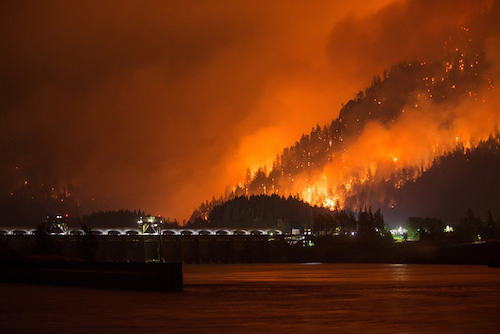Dear Reader,
Earlier this month, a fire broke out in the Columbia River Gorge National Scenic Area in Oregon. So far, the Eagle Creek Fire has burned close to 50,000 acres. As of this writing, it is still only 46% contained.
On Sept. 2, a local 15-year-old boy was spotted setting off fireworks in the dry gorge, which allegedly sparked the massive blaze. Now, kids make mistakes, but we can’t ignore the fact that this teenager’s actions put many lives in danger and caused massive damage and loss of property.

Photo courtesy of OregonLive.com.
In addition, the fire trapped over 140 hikers in the gorge. The group stuck together and made sure no one was left behind as they tried to find an alternate route. Due to the severity of the approaching wildfire, a helicopter dropped directions to the hikers to keep them on the safest path.
As they hiked into the night, the group was eventually met by firefighters who led them to safety. Their rescue came not a moment too soon — they were saved within 300 yards of the fire.
Only YOU Can Prevent Forest Fires
The reality is you can never be careless when you start a fire in the wild. Even in a survival situation, you need to consider the ramifications of starting a fire you might not be able to keep under control.
I realize that when you’re in survival mode, you become desperate and tend to focus on your immediate needs like food and warmth. But there are still a few very important considerations you MUST remember when picking a safe spot to build a fire.
1. Distance
Build your fire at least 15 feet away from trees, shrubs or anything that could ignite and cause the fire to spread. Don’t forget to check above — you need to make sure there aren’t any low-hanging branches that could catch.
I know many people will look for a spot near logs or other things they can sit on, but this can literally add fuel to the fire. So while it might be more comfortable or convenient, don’t start a fire near anything that could burn. Drag the logs you want to sit on to the fire, instead of bringing the fire to you.
2. Wind
Consider what would happen if a huge gust of wind blew through the area where you built your fire. Before you strike a match, think: Is your fire out in the open or on top of a ridge where a breeze could blow it out of control? To minimize your fire’s exposure to air currents, try to build it on a hillside or near a mountain or some other natural formation that will block the wind.
3. Ground
Once you have chosen a suitable location for your fire, prepare the ground where you plan to build it. Remove all leaves, brush, pine needles, twigs and grass. Clear the area of everything but dirt and move all other debris a safe distance away.
A fire pit would be ideal, but in a survival situation I probably wouldn’t take the time or energy to dig one. At the very least, you must thoroughly clear the area so you can build your fire on dirt.
4. Size
If you were ever involved in Boy Scouts or Girl Scouts, you may remember going camping and building huge roaring fires that you added wood to all night to keep going. In an emergency, you don’t need a huge fire. Instead, strive to build a smaller fire you can maintain and keep under control.
A small fire will still provide heat and can be used for cooking just as effectively as a larger fire (and it won’t give away your position as easily). Also, when the time comes for you to leave the area, you don’t want to leave a large fire still burning.
5. Putting It Out
All right, you’ve built a fire and enjoyed a nice meal, but now you need to keep moving and you don’t have time to stay until the fire is completely out.
The best thing to do is pour water over the fire. However, if you aren’t near a water source, I don’t recommend this, because you need to save your water for drinking.
The next best thing to do is to add dirt to the fire and stir it with a stick. You should also try to separate the fire, which will help it cool down quicker. In other words, if you separate the coals, they will be more exposed to the outside temperature. This will help them cool down faster than if you simply leave the embers in a pile.
Believe me, I understand that in a survival situation, your instinct is to do whatever you have to do to survive. But please — take these few, simple precautions when building a survival fire. You don’t want to be responsible for the costly mistake of starting a massive inferno like some dumb kid.
Stay safe,

Jason Hanson
Editor, Spy & Survival Briefing






